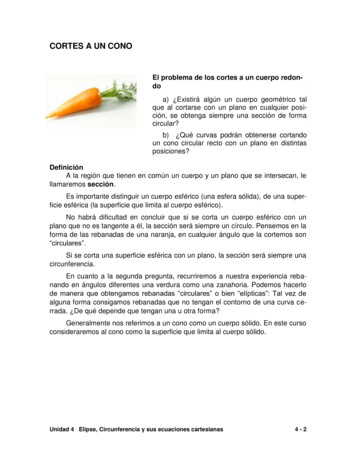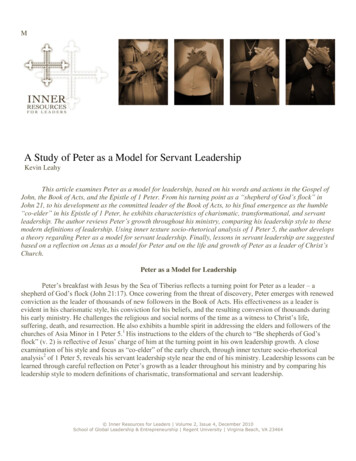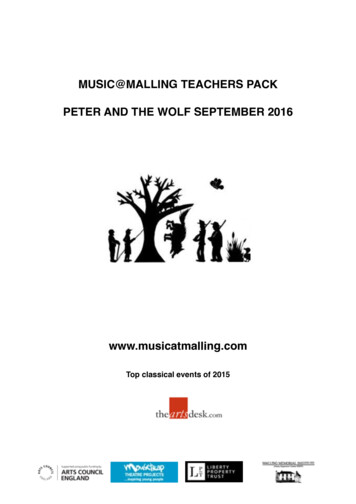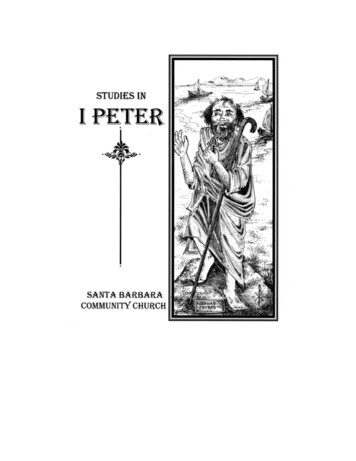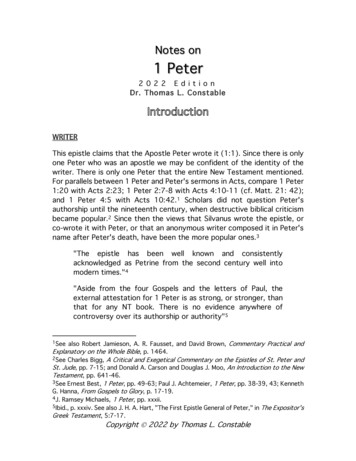
Transcription
Notes on1 Peter2 0 2 2 E d i t i o nDr. Thomas L. ConstableWRITERThis epistle claims that the Apostle Peter wrote it (1:1). Since there is onlyone Peter who was an apostle we may be confident of the identity of thewriter. There is only one Peter that the entire New Testament mentioned.For parallels between 1 Peter and Peter's sermons in Acts, compare 1 Peter1:20 with Acts 2:23; 1 Peter 2:7-8 with Acts 4:10-11 (cf. Matt. 21: 42);and 1 Peter 4:5 with Acts 10:42.1 Scholars did not question Peter'sauthorship until the nineteenth century, when destructive biblical criticismbecame popular.2 Since then the views that Silvanus wrote the epistle, orco-wrote it with Peter, or that an anonymous writer composed it in Peter'sname after Peter's death, have been the more popular ones.3"The epistle has been well known and consistentlyacknowledged as Petrine from the second century well intomodern times."4"Aside from the four Gospelsexternal attestation for 1 Peterthat for any NT book. Therecontroversy over its authorshipand the letters of Paul, theis as strong, or stronger, thanis no evidence anywhere ofor authority"51Seealso Robert Jamieson, A. R. Fausset, and David Brown, Commentary Practical andExplanatory on the Whole Bible, p. 1464.2See Charles Bigg, A Critical and Exegetical Commentary on the Epistles of St. Peter andSt. Jude, pp. 7-15; and Donald A. Carson and Douglas J. Moo, An Introduction to the NewTestament, pp. 641-46.3See Ernest Best, 1 Peter, pp. 49-63; Paul J. Achtemeier, 1 Peter, pp. 38-39, 43; KennethG. Hanna, From Gospels to Glory, p. 17-19.4J. Ramsey Michaels, 1 Peter, pp. xxxii.5Ibid., p. xxxiv. See also J. H. A. Hart, "The First Epistle General of Peter," in The Expositor'sGreek Testament, 5:7-17.Copyright Ó 2022 by Thomas L. Constable
Dr. Constable's Notes on 1 Peter22022 EditionIn contrast, there has been much controversy over the authorship of 2Peter.RECIPIENTSPeter first sent this letter to believers living in the northern regions of theRoman province of Asia Minor (modern western Turkey; 1:1). This was nota region that either Peter or Paul ever evangelized as far as we know. Thelocations of these Christians, as well as allusions in the epistle, indicate thatthey were mainly Gentiles but also Jews (cf. 1:14, 18; 2:9-10, 25; 3:6; 4:34).DATEPeter died in the 60s A.D. and spent the last decade of his life in Romeaccording to reliable tradition. The exact date of Peter's martyrdom is amatter of debate among scholars. Some believe that the traditional dateof Peter's death was A.D. 64.1 Another scholar claimed that it was A.D.67.2 Many interpreters have regarded Peter's reference to Babylon (5:13)as a coded reference to Rome, which Peter described as Babylon in orderto highlight its paganism."Since the historical city of Babylon in Mesopotamia, oftenmentioned in the pages of the Old Testament, had no Jewishpopulation in Peter's day (see Josephus, Ant. 18.371-79) andwas almost deserted in A.D. 115 when the Emperor Trajanvisited, almost no one thinks Peter wrote his letter from there.Another, very small Roman military colony in Egypt called'Babylon' existed in Peter's day, but this too is a very unlikelyprovenance [place of origin] for 1 Peter."3In view of all this information it seems likely that Peter wrote this epistlefrom Rome about A.D. 64.41PeterH. Davids, The First Epistle of Peter, p. 8; Hart, 5:17.Goppelt, A Commentary on I Peter, pp. 10-14.3Carson and Moo, p. 646. See also Hanna, p. 420.4See my comments on 5:13 for additional support for this conclusion.2Leonhard
2022 EditionDr. Constable's Notes on 1 Peter3SPECIAL FEATURESTheologically this epistle is eschatological (dealing with the end times).Along with its eschatological focus there is much emphasis on holiness(personal, social, and communal), hope, salvation, community, relationshipto the world, the Trinity, and especially suffering.1"The keynote is 'Suffering and Glory.' The words suffering andsuffer occur fifteen times and the word glory ten times."2"As some scholars have pointed out, the letter is concernedas much, if not more, with Christian action in the world as withChristian suffering."3"Nowhere in the New Testament are the priestly and theprophetic elements in Christianity so closely fused as in IPeter."4" much of the material in 1 Peter is the stuff of basicChristian teaching rather than advanced instruction thatassumes the mastery (and perhaps the perversion) of thebasics, as in the Pauline letters."5" despite its brevity—only 105 verses in all—it is amicrocosm of Christian faith and duty, the model of a pastoralcharge, composed of divers materials and of many themes."6"Probably no other letter in the New Testament is said to relyso much on traditional material as is 1 Peter. Scholarsestimate that no other book in the New Testament, with theexception of Hebrews and Revelation, depends so heavily onthe Old Testament."71Forfurther discussion, see Davids, pp. 14-23, 30-44; Michaels, pp. lxvii-lxxv; and JamesE. Allman, "Suffering in the Non-Pauline Epistles," in Why, O God? Suffering and Disabilityin the Bible and Church, pp 195-205.2Arno C. Gaebelein, The Annotated Bible, 4:2:56.3I. Howard Marshall, 1 Peter, p. 16.4E. G. Selwyn, The First Epistle of Peter, p. 2.5Davids, p. 11.6Selwyn, p. 1.7Carson and Moo, p. 640.
Dr. Constable's Notes on 1 Peter42022 Edition"The Greek of the letter is smooth and competent, withrhetorical flourishes. Indeed, along with Hebrews and LukeActs, it is some of the best Greek in the New Testament."1"In many respects, 1 Peter and James form a matched pairwithin the NT canon. They are Christian diaspora lettersroughly similar in length, one directed (probably fromJerusalem) to scattered messianic Jews (i.e., Christians) whoare real Jews, and the other directed from 'Babylon' toscattered 'Jews' who are in fact Gentile Christians."2As James is an exposition of Jesus' Sermon on the Mount as recorded inMatthew 5—7, 1 Peter expounds some of the same themes that Jesustaught in His discipleship discourse in Matthew 10."Peter's motivation for action differs from both Paul and John.All three call for a life of faith in Christ in obedience to Hiscommands. But the basis of motivation differs among thethree. Paul bases much (though not all) of his application onjustification realities, or positional truths. He calls people toaction based on what God has done. John calls for action onthe basis of sanctification realities, and what God is doing inthem. Peter bases his motivation on glorification realities, andwhat God has promised to do. This needs to be understood sothat Peter's discussion of salvation will not be reduced to adescription of justification. He speaks to believers, and onlyoccasionally does he refer to their justification when discussingtheir salvation. He more often points them to glorificationrealities."3PURPOSEPeter stated his reason for writing, namely, to encourage his readers, whowere facing persecution for their faith, to stand firm (5:12). Evidently this1Ibid,p. 642.p. xlvii. See E. M. Sidebottom, James, Jude, 2 Peter, pp. 15-16, for othersimilarities between 1 Peter and James.3Gary Derickson, "The First Epistle of Peter," in The Grace New Testament Commentary,2:1145.2Michaels,
2022 EditionDr. Constable's Notes on 1 Peter5persecution was widespread among his readers. Local enemies of thegospel were not the only people responsible for it. When Paul traveledaround the Roman Empire preaching the gospel, some churches that heplanted experienced persecution from the unsaved in their communities,but others did not. However 1 Peter reflects persecution of the Christiansthroughout northern Asia Minor. This condition prevailed after Nero blamedthe Christians for burning Rome in July of A.D. 64. While persecution seemsto have been widespread, it may not have been official yet.1" it seems that state action [against Christians] was rare(Pliny acted only when prosecutions were brought that hecould not overlook) and that what Christians had to fear wasmore in the nature of social ostracism, unfriendly acts byneighbors, pressure on Christian wives from pagan husbands,masters taking it out on Christian slaves and other actions ofthat kind."2"The Letter stresses life triumphant in conduct; life triumphantin character; life triumphant in conflict."3OUTLINEI.II.Introduction 1:1-2The identity of Christians 1:3—2:10A.Our great salvation 1:3-121.2.3.B.Our new way of life 1:13-251.2.3.1Selwyn,The hope of our salvation 1:3-5The joy of our salvation 1:6-9The witnesses of our salvation 1:10-12A life of holiness 1:13-16A life of reverence 1:17-21A life of love 1:22-25pp. 52-56.p. 14. See also Achtemeier, pp. 28-36.3G. Campbell Morgan, The Unfolding Message of the Bible, p. 380.2Marshall,
Dr. Constable's Notes on 1 Peter6C.Our priestly calling 2:1-101.2.3.4.III.Our mission in the world 2:11-12Respect for others 2:13—3:121.2.3.4.5.C.D.Respect for everyone 2:13-17Slaves' respect for their masters 2:18-25Wives' respect for their husbands 3:1-6Husbands' respect for their wives 3:7The importance of loving enemies 3:8-12Eventual vindication 3:13—4:61.2.3.Suffering for doing good 3:13-17The vindication of Christ 3:18-22Living with the promise in view 4:1-6The importance of mutual love in end-times living 4:7-11The responsibilities of Christians collectively 4:12—5:11A.The fiery trial 4:12-191.2.B.Suffering and glory 4:12-14Suffering as Christians 4:15-19The church under trial 5:1-111.2.3.4.V.Listening to God 2:1-3Growing in God 2:4-5Building on Christ 2:6-8Summary affirmation of our identity 2:9-10The responsibilities of Christians individually 2:11—4:11A.B.IV.2022 EditionTheTheTheTheresponsibilities of the elders 5:1-4responsibilities of the others 5:5importance of humility and trust in God 5:6-7importance of resisting the devil 5:8-11Conclusion 5:12-14
2022 EditionDr. Constable's Notes on 1 Peter7MESSAGEOne writer has identified five major motifs in 1 Peter. These are: (1) thebeliever's behavior, (2) the believer's unfair circumstances, (3) thebeliever's deference, (4) the believer's motivation by Christ's example, and(5) the believer's anticipation of future glory. Putting these together, hehas stated the message of 1 Peter as follows:"The behavior of believers when they encounter unfaircircumstances reflects a spirit of deference in all relationshipsas they follow Christ's example and anticipate future glory."1This is a very fine statement of what the Holy Spirit has said to us throughPeter in this epistle. However I would add one more important motif. It isthe believer's resource of God's grace. This is not an incidental motif butone that underlies all of what Peter called upon his readers to do. We mustunderstand and apply what he wrote about God's grace as our resource inorder to obey his exhortations.It seems to me that Peter stated the message of this epistle clearly: "thisis the true grace of God. Stand firm in it!" (5:12).2The subject of the letter, therefore, is the true grace of God. Grace is thekey word in the argument of this epistle. Wherever it occurs, the wordgrace appears in the practical rather than in the doctrinal part of eachsection of the letter. Throughout 1 Peter the fact of God's grace was inPeter's mind as crucial to the believer's practice. How does one explainGod's grace? Grace means both undeserved favor and divine enablement.A good synonym is God's help.The main purpose of this epistle was to strengthen the readers so thatthey would persevere through their trials with the right attitude. Peter didthis by showing that God's grace provided all that they needed for strength.In a larger sense the purpose was to help Christians know how to live asaliens in the world.1JamesR. Slaughter, "The Importance of Literary Argument for Understanding 1 Peter,"Bibliotheca Sacra 152:605 (January-March 1995):80.2Quotationsfrom the English Bible in these notes are from the New American StandardBible (NASB), 2020 edition, unless otherwise indicated.
8Dr. Constable's Notes on 1 Peter2022 EditionThis epistle reveals above all else that God's grace is sufficient for all ourneeds. We could write over this whole book 2 Corinthians 12:9: "My graceis sufficient for you." Notice five things that Peter reminds us about God'sgrace as we trace his references to grace though 1 Peter:First, grace proceeds from God. God in His grace has chosen Christians(1:2a). Now we need to appropriate God's grace in its fullest measure inour experience (1:2b).Second, grace produces confidence. The prophets foretold God's grace(1:10). The two advents of Jesus Christ supply God's grace (1:13). Gracecame into the world at His first advent through His sufferings and death. Itwill come into the world again at His second advent through Hisglorification. This pattern gives us confidence. God has united us withChrist. As He suffered once, we suffer now. As certainly as He will receiveglory in the future, we too will experience glorification in the future. Weneed to remember our hope. (cf. James 1).Third, what proclaims God's grace is our conduct (2:19-20). The Christian'sconduct in trying and difficult circumstances manifests God's grace in ahuman life. The submissive conduct of servants whose masters arepersecuting them manifests God's grace. The submissive conduct of wiveswhose antagonistic husbands are persecuting them manifests grace. Thesubmissive conduct of husbands whom unbelievers are persecutingmanifests grace. The husband demonstrates his submission to God bytreating his wife as a fellow heir of God's grace (3:7). Our patient enduranceof trials displays our submission to God's will. Thus the Christian's conductshould manifest God's grace. Sometimes we marvel at the ability that Godgives his persecuted saints to endure. We say: How can he (or she) do it?They can do it because God provides grace.Fourth, grace perfects character. Grace is the source of service (4:10).Grace is also the source of humility (5:5). An attitude of humility manifestsitself in service of others. God's grace is the secret of both the attitudeand the activity. Jesus established the so-called Order of the Towel bywashing the disciples' feet (John 13).Fifth, grace promotes courage (5:10). We need courage to resist the devil(5:8-9). God's grace gives us strength to defend ourselves against hisattacks.
2022 EditionDr. Constable's Notes on 1 Peter9This epistle exhorts us to stand firm in this grace (5:12). This is Peter'sappeal to his Christian readers.When God tries our faith, we need to remember that we have an adequatesource of strength in God's grace (2 Cor. 12:9).When our faith is trembling, we need to remember that we have anadequate source of confidence in God's grace. This is not simply positivethinking but real external help.When our circumstances are difficult, we need to remember that we havean adequate source of conduct in God's grace, not just pep talks.When we suffer for conscience's sake, we need to remember that we havean adequate source of character in God's grace, not just self-effort.When assaulted by the adversary, we need to remember that we have anadequate source of courage in God's grace. Some need courage toevangelize, others need it to do other forms of ministry.We stand firm in the true grace of God when we respond to suffering forChrist's sake as Peter directed. God's grace is what we need to rely on aswe commit ourselves to continue to walk in the will of God. We need totrust and obey.11Adapted58.from G. Campbell Morgan, Living Messages of the Books of the Bible, 2:2:143-
10I.Dr. Constable's Notes on 1 Peter2022 EditionINTRODUCTION 1:1-2Peter began this epistle in the manner that was customary in his day.1 Heintroduced himself to his original readers, and he wished God's blessing onthem in order to prepare them for what he had to say. He prepared themfor dealing with trials by reminding them of who they were, what they had,and where they were going (vv. 1-5).1:1Peter is a Greek name (lit. Petros, meaning a stone or rock).No one else in the New Testament has the name Peter, thoughPeter called Christians stones in this epistle (2:4-5). InAramaic, stone is the word cephas. Jesus gave the nameCephas (Peter) to Simon (the Greek transliteration of Simeon,Peter's original Hebrew name) as a prediction of what thisapostle would become (John 1:42; Matt. 16:18).The word apostle has both a technical and a general sense inthe New Testament. It refers to the Twelve and Paul, but alsoto others who went out just as the Twelve and Paul did torepresent Jesus Christ (cf. Acts 14:4, 14). Peter was one ofthe Twelve, and he wrote with full apostolic authority."To pretend to what we have not is hypocrisy; andto deny what we have is ingratitude."2Peter called his readers strangers in order to introduce thisself-concept into their minds. In this letter he emphasized thatChristians are really citizens of heaven and that our sojournhere on earth is only temporary (2:11; cf. Gen. 32:4; Ps.39:12). The Greek word perepidemos (stranger) contains boththe ideas of alien nationality and temporary residence (cf.2:11; Heb. 11:13)."Parepidemoi are persons who belong to someother land and people, who are temporarily1SeePhilip L. Tite, "The Compositional Function of the Petrine Prescript: A Look at 1 Pet1:1-3," Journal of the Evangelical Theological Society 39:1 (March 1996):47-56.2Matthew Henry, Commentary on the Whole Bible, p. 1939.
2022 EditionDr. Constable's Notes on 1 Peter11residing with a people to whom they do notbelong. Aliens are often held in contempt bythe natives among whom they dwell."1"Christians, if they rightly consider their calling,must never settle themselves here, but feelthemselves travellers [sic]."2"This is an epistle from the homeless to thehomeless."3The particular group of Christians to whom this epistle firstwent lived in the northern Roman provinces of Asia Minor northof the Taurus Mountains.4 Peter Davids estimated that whenPeter wrote this epistle, about one million Jews lived in Israel,and two to four million lived outside it. Asia Minor held the thirdlargest concentration of Diaspora Jews [Jews who livedoutside Israel] after Babylon and Egypt.5PONTUSBITHYNIACAPPADOCIAGALATIAASIALYCIA PAMPHYLIACILICIAROMAN PROVINCESIN ASIA MINOR1RichardC. H. Lenski, The Interpretation of the Epistles of St. Peter, St. John, and St. Jude,p. 21. Paragraph division omitted.2Jamieson, et al., p. 1464.3Michaels, p. 9.4See Best, pp. 14-15.5Davids, p. 46.
12Dr. Constable's Notes on 1 Peter2022 EditionThis was originally an encyclical letter: one that was written forcirculation among the addressees. The sequence of listedprovinces corresponds to the route that the bearer of theoriginal epistle would have normally followed as he traveledthrough this region.1 This is also true of the seven citiesaddressed in Revelation 2 and 3.Peter's readers were God's elect (Eph. 1:4; cf. Deut. 14:2; Isa.45:4). One writer believed that the word chosen should beconnected with the word strangers: chosen strangers.2However most translators regarded the word chosen as anoun, not an adjective.3" the letter develops a unified thematic focus:the existence of Christians in a non-Christiansociety and overcoming that society by beingprepared to bear oppression, i.e., to 'suffer.' Thisthematic focus, i.e., the question of how to live insociety—the fundamental problem of every socialethic—was for Jesus' disciples from the verybeginning an acute problem."41:21F.Divine election ("chosen," v. 1) originates in the eternal willand purpose of God the Father. The foreknowledge (Gr.prognosin; cf. Acts 2:23) of God refers, of course, to what Godknows beforehand. God's foreknowledge has an element ofdeterminism in it, because whatever really happens—whichGod knows beforehand, namely, everything—exists or takesplace because of His sovereign will.5 Therefore when Peterwrote that God chose his readers according to Hisforeknowledge, he did not mean that God chose the electbecause He knew beforehand that they would believe thegospel (the Arminian position). God chose them because Hedetermined beforehand that they would believe the gospelJ. A. Hort, The First Epistle of St. Peter 1:1—2:17, pp. 157-84; Selwyn, p. 119;Goppelt, p. 4.2D. Edmond Hiebert, "Designation of the Readers in 1 Peter 1:1-2," Bibliotheca Sacra137:545 (January-March 1980):65.3E.g., Bigg, p. 90.4Goppelt, p. 19. Paragraph division omitted.5See Best, pp. 70-71.
2022 EditionDr. Constable's Notes on 1 Peter13(the Calvinist position; cf. Rom. 8:29-30; Eph. 1:3-6; 1 Thess.1:4; 1 Peter 5:13).1"When applied to God's knowledge of persons(whether of Jesus or his people), 'foreknowledge'is more than mere prescience [knowing somethingbefore it takes place], it involves choice ordetermination as well (cf. Acts 2:23—the onlyother NT use of the noun—and Jud 9:6; also theverb proginoskein, 'know,' in Rom 8:29 and 11:2,as well as 1 Pet 1:20). In this sense God 'knows'some people and not others, whereas a generalprescience would be all inclusive (cf. theparticularized use of 'know' in Amos 3:2; Hos 5:3;12:1 [LXX]; 1 Cor 8:3; Gal 4:9)."2The Holy Spirit accomplished election when He separated theelect from the rest of humanity and set them aside for aspecial calling. This is the sanctifying work of the Spirit. God'spurpose in election was that the elect might obey God the Son,and that He might sprinkle us with His blood (cf. Eph. 2:10)."To 'sprinkle with Christ's blood' means to take aperson into the realm of influence of Christ'sdying, to align him or her with the One who died.This alignment accomplishes, as the figureexpresses graphically, purification and therebyappropriation into a new connection to God."3This is probably an allusion to covenant ratification (cf. Exod.24:5-8). Jesus' blood ratified (made valid) the New Covenant(cf. Matt. 26:27-28; Mark 14:23-24; Luke 22:20), since it was1Forfurther explanation of the Calvinist position, see Lewis S. Chafer, SystematicTheology, 7:158-60.2Michaels,pp. 10-11. LXX refers to the Septuagint (Greek) translation of the OldTestament that was made in the third century B.C. Cf. Henry, p. 1939.3Goppelt, p. 75. Cf. Bigg, p. 93.
14Dr. Constable's Notes on 1 Peter2022 Editionthe basis for the forgiveness of sins (as promised in Jeremiah31:31-34).1"Peter's choice of images confirms the impressionthat he writes to communities of Gentiles as ifthey were a strange new kind of Jew."2In this verse Peter referred to all three members of the Trinity."The primary import of the three clauses [thatbegin verse 2] is to open up clearly at the outsetof the Epistle the transcendent origin, nature, andpurpose of the Church and its life."3Probably Peter had Old Testament sprinkling of blood in mindwhen he wrote this verse. There are many Old Testamentallusions in this epistle, which we would expect from a Jewishwriter. Sprinkling with blood in Israel resulted in cleansing(Num. 19:9), bringing the person sprinkled under the termsand blessings of a covenant (Exod. 24:3-8), and induction intothe priesthood and/or kingship.Members of the priesthood enjoyed the privilege of mediatingbetween God and people (Exod. 29:21; Lev. 8:30). Membersof the royal line in Israel enjoyed the privilege of reigning underGod. All of these benefits belong to the Christian as well, whomGod has figuratively sprinkled with the blood of Jesus Christ:the final Sacrifice for our sins. Obedience is our responsibility,and sprinkling is our privilege. Christ's blood covers our sins assinners, cleanses our defilement as unclean people, andconsecrates our service as priests and kings (cf. 2:9)."The author sees himself and his readers as acommunity situated in the world in much the same1BuistM. Fanning, "A Theology of Peter and Jude," in A Biblical Theology of the NewTestament, pp. 441-42.2Michaels, p. 13.3Selwyn, p. 119.
2022 EditionDr. Constable's Notes on 1 Peter15way the Jews are situated, and sharing with theJews a common past."1Peter prayed for God's fullest outpouring of His favor and helpon his readers. They needed this in order to make it throughtheir present sufferings and survive spiritually, which sufferingsPeter proceeded to discuss. His readers also needed God's giftof peace since they were suffering."In looking back over Peter's designation of hisreaders, one is awed by the sweep and richness ofhis statement. If one has been prone to think ofPeter primarily as an aggressive man of action, hehere reveals himself also as a man who had a firmgrasp of the great spiritual realities of the faith."2II.THE IDENTITY OF CHRISTIANS 1:3—2:10The essentially chiastic structure of thought in the letter, excluding theintroduction and conclusion, can be visualized in the outline (seeIntroduction).3 The recurrence of the direct address "Beloved" in 2:11 and4:12 divides this letter into three main parts."The theme of the first part is the identity of the people ofGod established on the basis of the great salvation Christ hasaccomplished (and is accomplishing) on their behalf. Theiridentity as a 'chosen' people is affirmed programmatically inthe address (1:1-2) and confirmed in the concludingpronouncements of 2:9-10 so as to form an inclusio. Morebroadly, there is an inclusion between the emphasis on theidentity of Christians in the first section (1:1-12) and lastsection (2:1-10) of part one. In the first section, they are1Michaels,p. l.pp. 73-74.3A chiasmus is a rhetorical or literary figure in which words, grammatical constructions, orconcepts are repeated in reverse order, in the same or a modified form.2Hiebert,
Dr. Constable's Notes on 1 Peter162022 Edition'chosen' as heirs of divine salvation, while in the last theirelection is confirmed by the metaphor of priesthood."1Peter began the body of this epistle by reminding his readers of theiridentity as Christians. He did this to enable them to rejoice in the midst ofpresent suffering. They could glory (rejoice) in their sufferings since theywould ultimately experience glorification. The tone of this entire epistle iswarm, pastoral, and full of encouragement. In it Peter partially fulfilledJesus' instructions to him to take care of the Lord's flock (John 21:15-17).A.OUR GREAT SALVATION 1:3-12The first part of this section, on who we are as Christians, is a revelation ofour great salvation. Some have called it the Great Doxology. In thisdoxology Peter reminded us of our hope, our joy, and the witnesses of oursalvation. He did this so that we would appreciate how greatly God hasblessed us. God the Father is central in this section.1.1:3The hope of our salvation 1:3-5Peter called on his readers to bless (praise) God for giving usa living hope, "not merely an empty wish."2 This undying hopehas its roots in the resurrection of Jesus Christ. Because Helives we shall live. Our new birth gave us this life. Consequentlyour hope is both alive within us and part of our new life inChrist."Just as 'faith' can be subjective (the act or stateof believing), or objective (the content of belief),so 'hope' can refer either to an anticipation (evena certainty) of good things to come or to thecontent of that anticipation, the good thingsthemselves. The 'living hope' of which Peterspeaks here is better understood in the second,objective, sense. As such, it appropriatelyparallels, and is further explained by, the1Michaels,p. xxxiv. An inclusio is a literary device based on a concentric principle, alsoknown as bracketing, bookending, or an envelope structure, which consists of creating aframe by placing similar material at the beginning and end of a section.2Achtemeier, p. 95.
2022 EditionDr. Constable's Notes on 1 Peter17'inheritance' of v 4 and the 'salvation' of v 5 (cf.Col 1:5 )."1Alford understood this living hope in the first, subjective sense:" it is a life of hope, a life in which hope is theenergizing principle."2Many popular writers have called Paul the apostle of faith, Johnthe apostle of love, and Peter the apostle of hope. They havedone so because of the dominant emphasis that each of thesewriters made in the New Testament. Peter had much to sayabout hope in this epistle.3When James wrote of salvation, the particular aspect ofsalvation that he usually had in view was practical (also calledprogressive) sanctification. When Peter wrote of salvation inthis epistle, the particular aspect of salvation that he usuallyhad in view was glorification."While Peter's teaching on how salvation is appliedgave attention to the beginning and continuedprocess of living as a Christian, the actual wordsfor 'salvation' have a predominantly futureorientation in 1 Peter."4"Born again" (cf. v. 23) describes the Christian who hasexperienced spiritual regeneration (John 3:3). The phrasestresses the great change that takes place at conversion andour resultant participation in the life of God. God has beenexceedingly merciful in giving us this blessing (cf. Rom. 11:3032; 15:9; Eph. 2:1-7; Titus 3:5). In this verse the aspect ofsalvation that is in view is justification. One writer consideredsalvation the major theme of this epistle.51Michaels,p. 19. See also John Calvin, Institutes of the Christian Religion, 3:2:42.Alford, The Greek Testament, 4:2:333.3See Gerhardus Vos, "A Sermon on I Peter 1:3-5," Kerux 1:2 (September 1986):4-17.4Fanning, p. 447.5Paul A. Cedar, James, 1, 2 Peter, Jude, p. 120.2Henry
18Dr. Constable's Notes on 1 Peter2022 Edition"The Christian is as incapable of starting himselfon the new life as he was of conceiving himself forhis first life."1"A child of God has no right to look on the darkside of things, and to look for the worst to happento him. As the object of God's care and love, hehas the right to look for the best to come to himand to look on the bright side of things [cf. Prov.4:18-19]."21:4As the Israelites who wandered in the wilderness anticipatedtheir inheritance in the Promised Land, so we who areChristians should anticipate ours the other side of the grave.However
3G. Campbell Morgan, The Unfolding Message of the Bible, p. 380. 6 Dr. Constable's Notes on 1 Peter 2022 Edition C. Our priestly calling 2:1-10 1. Listening to God 2:1-3 2. Growing in God 2:4-5 3. Building on Christ 2:6-8 4. Summary affirmation of our identity 2:9-10 III. .
